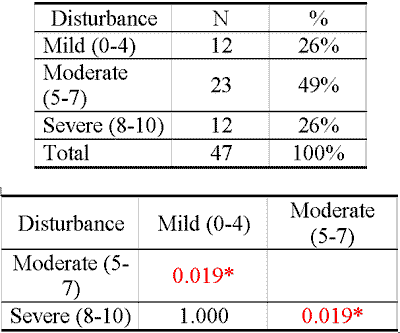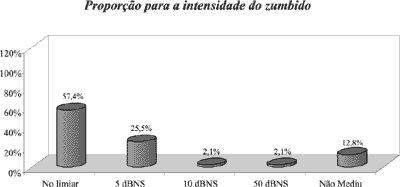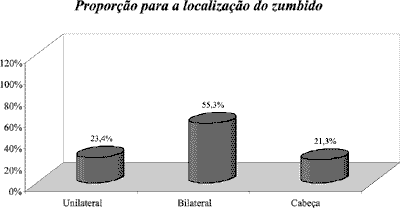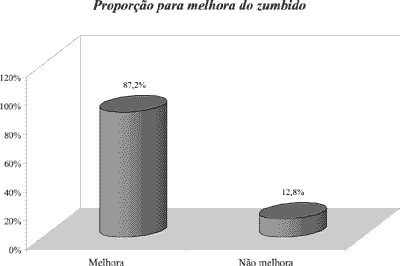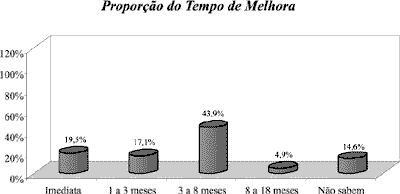

Year: 2004 Vol. 70 Ed. 5 - (7º)
Artigo Original
Pages: 624 to 631
The efficacy of hearing aid fitting on diminishing or eliminating tinnitus
Author(s):
Lívia Oliveira Salgueiro de Moura1,
Maria Cecília Martinelli Iório2,
Marisa Frasson de Azevedo3
Keywords: tinnitus, hearing loss, hearing aids.
Abstract:
Introduction: Tinnitus is a disorder extremely frequent in patients with hearing loss. It affects more than 40 milion people in the USA, affecting about 1/3 of the population above 65 years old. Clinical experience has been demonstrating that patients with hearing loss and tinnitus have great benefits with the hearing aid because it helps out the comprehension of conversation while relieves tinnitus. In this work, we have studied the efficacy of hearing aids on diminishing or eliminating tinnitus in patients with hearing loss. Material and Method: We evaluated 47 patients (32 women and 15 men) with ages ranging from 32 to 88 years old and medical indication for fitting a hearing aid. We subjectively investigated the sensation of tinnitus matching frequency (Hz) and loudness (dB) through the technic of acuphenometry and we have attended the patients for one year aiming to verify if there was a relief of tinnitus after the hearing aid fitting. Results: The majority of patients (87,2%) refered relief of tinnitus with the use of the hearing aid. In 51% of these patients tinnitus has completely desapeared. It was necessary to use the hearing aid for some months (3-8) to obtain the relief of tinnitus in the majority of patients. The characteristics of the hearing aids, as model, tecnology and vent, had no influence on the relief of tinnitus. Conclusions: The use of the hearing aid was effective in reducing or eliminating tinnitus in patients with hearing loss and tinnitus.
![]()
INTRODUCTION
Tinnitus represents a great challenge for clinicians and researchers. It is an extremely common disorder reaching about 40 million people in the USA, out of which 10 million are severely affected. Tinnitus affects about 1/3 of the population aged over 65 years. The common attitude of many professionals is to send patients back home and say "there is nothing to do but to learn how to live with tinnitus" 1.
Different authors agree on the fact that tinnitus involves abnormalities both of cochlear function and signal processing, related to the central nervous system. Moreover, tinnitus should not be seen only as a signal perception originated from an isolated and localized generator 2-4.
According to Salvi et al.3, a decrease in auditory stimulus, even if temporary, leads to increase in sensitivity of subcortical center neurons. In some cases, tinnitus can be caused by increased sensitivity in subcortical centers of auditory system. Thus, it may be treated based on the decrease of this sensitivity.
Hearing aids and sound generators (white noise) have been incorporated to a protocol that uses progressive auditory stimuli for prolonged periods of time. Data from neurosciences emphasize that these plastic changes require prolonged periods of time, measured in weeks or month 4.
Some authors proposed as the clinical objective of tinnitus management to remove tinnitus perception from patients' awareness level and to start and facilitate the process of habituation to tinnitus. This process involves changes to the strength of functional connections between the neurons involved in tinnitus signal processing, to reduce detection and transmission of signals to emotional centers of the brain 2, 4.
Clinical practice has demonstrated that patients with hearing loss associated with tinnitus benefit from the use of hearing aids, because in addition to improvement in understanding of conversation, there is tinnitus relief.
Different authors recommend hearing aid fitting in patients with hearing loss followed by tinnitus as an effective alternative to its improvement 4-6.
A study conducted by Surr et al.7 demonstrated that approximately 50% of the patients assessed found that the hearing aid was effective to reduce or eliminate tinnitus.
Considering these data, the present study aimed at:
" check efficiency of hearing aid fitting in reducing or eliminating tinnitus in patients with hearing loss;
" characterize tinnitus;
" check other factors that may interfere in tinnitus improvement, such as time of use and hearing aid characteristics.
MATERIAL AND METHOD
We assessed 47 adult subjects, 32 female and 15 male, aged 32 to 88 years, all of them with tinnitus and hearing loss complaints, ranging in grade from mild to profound, uni or bilateral, sensorineural, with medical indication of hearing aid fitting.
Subjects came to the hearing aid company in Sao José dos Campos, underwent detailed clinical history, pure tone audiometry, speech audiometry and hearing aid selection. Subjects classified tinnitus according to level of disturbance in a 0 to 10 scale, in which tinnitus was classified as mild (0 to 4), moderate (5 to 7) or severe (8 to 10), as provided by the scale used in the ambulatory of tinnitus, Hospital das Clínicas, Sao Paulo. Description of used procedures:
1) Pure tone audiometry: soundproof booth test to determine the lowest intensity in which the subjects could detect pure tone. All tests were conducted in the same audiometer, VSC2090-AUDITEC. Audibility thresholds were normal if up to 25 dBHL; from 26 to 40 dBHL, mild loss; from 41 to 70, moderate loss, and from 71 to 90, profound loss.
2) SRT (speech reception threshold): soundproof booth test to determine lowest intensity in which the subjects could recognize 50% of the stimuli (words) presented to each ear.
3) Speech recognition percentage index (SRI): soundproof booth test of speech recognition in percentage of correct responses, in ideal conditions of acoustic environment and sound intensity.
4) Hearing aid selection: initially, we investigated level of discomfort, which consisted of a test in the soundproof booth to determine which was the loudest sound the subjects could stand in each ear with pure tone presentation. The subjects tried on different hearing aids, all compatible with the hearing loss, and we selected the model that provided better gain and comfort to the patients.
Subjects were submitted to tinnitus sound definition, named acuphenometry, investigating pitch and loudness of tinnitus as follows: pure tone or narrow band noise (depending on type of tinnitus reported by the patient) was presented to the ear contralateral to tinnitus at 15dBSL in different frequencies, up to when the subject identified the frequency closer to the tinnitus, determining its pitch. Next, at the defined frequency, we decreased intensity of stimuli in 5dB steps up to when the subject identified the closest intensity to the tinnitus, determining its loudness. After hearing aid fitting, subjects were followed up every six months to investigate, through clinical history, the reduction or elimination of tinnitus with hearing aid use.
Moreover, we analyzed previous protocols of patients that presented hearing loss associated with tinnitus at the time of clinical history who had purchased hearing aids. Those patients were invited to join the study and were enrolled in the sample.
The present study was analyzed and approved by the Research Ethics Committee, Federal University of Sao Paulo/Hospital Sao Paulo, under protocol nº 0831/02. After information and consent to participate in the study, patients' data were inputted in the assessment protocol and later statistically analyzed so as to investigate whether the use of hearing aid was effective to reduce or eliminate tinnitus.
Statistical Methodology
We used the Two-proportion test, a parametric technique that compares whether the proportion of responses to two variables and/or their levels is statistically significant. This test was used to characterize the sample and to characterize tinnitus.
The other used test was chi-square for independence, which is a non-parametric test used to check whether two variables and their levels have statistical dependence (association). This test was used to check factors that interfered in tinnitus improvement.
We adopted significance level of 0.05 (5%).
The confidence interval used was 95% confidence.
RESULTS
The sample was characterized concerning age, level of hearing loss and type of hearing aid fitting.
The age of studied subjects ranged from 32 to 88 years, mean age of 65.5 (standard deviation of 13.8) and median of 66 years. The confidence interval ranged from 61.6 to 69.5.
In the results of audiometry, there was predominance of moderate hearing loss (44.6%), with no statistically significant difference from moderately severe loss (29.7%). Severe (6.4%) and profound (4.3%) hearing losses were statistically significant less frequent.
As to type of hearing aid fitting, we observed that 40 subjects (85.1%) decided for monoaural adaptation, being that 25 (62.5%) on the right and 15 (37.5%) on the left. Seven subjects (14.9%) decided for binaural fitting.
Loudness of tinnitus in the studied population is shown in Graph 1.
As to pitch of tinnitus, 53.2% of the subjects had low pitch and 46.8% had high pitch.
Location of tinnitus in the studied population is shown in Graph 2.
Considering only unilateral location, there was no proportional difference in occurrence of tinnitus in relation to each side and 7 subjects (63.3%) had tinnitus on the right and 4 subjects (36.4%) had tinnitus on the left.
Thirty-nine subjects (83%) presented constant tinnitus, with statistically significant difference from intermittent tinnitus (17%).
The level of tinnitus disturbance in the studied population is shown in Table 1.
We tried to check whether there would be dependence between tinnitus loudness and grade of disturbance informed by subjects. There was no statistically significant dependence, but p-value was very close to the acceptable level, so we can state that there is a tendency to occur dependency between tinnitus intensity and level of disturbance.
There was statistically significant improvement of tinnitus with hearing aid use, as shown in Graph 3.
We analyzed the factors that could interfere in tinnitus improvement:
" Age of subjects
" Time of hearing aid use
" Hearing aid characteristics (vent, model and technology)
" Tinnitus characterization (Location, Constance, Intensity and Frequency)
There was no statistically significant dependence between age of subjects and tinnitus improvement with hearing aid.
In subjects that improved, the time of hearing use necessary to improve tinnitus was three to eight months for most subjects (43.9%), statistically different from other periods of time. Graph 4 illustrates the time of use necessary for tinnitus improvement in the studied subjects.
We studied types of hearing aid and model (esthetical characteristics). First of all, we detected the proportion of subjects with each model of hearing aid. Models of hearing aids used by the patients in the sample were: behind-the-ear, intraauricular, intracanal and microcanal, described by Almeida and Iório (1996). Most of the subjects (38.3%) used intracanal. Fifteen subjects (31.9%) used behind-the-ear, 4 subjects (8.5%) had intraauricular and 10 subjects (21.27%) had microcanal aids.
There was no statistically significant association between tinnitus improvement and model of hearing aid.
As to hearing aid technology, analog was more common and it was statistically different from the others, which were proportionally employed in the same way. Thirty-one subjects (65.9%) used analog aids, 10 subjects (21.3%) used programmable aids, and 6 (12.8%) used digital aids.
Technology of hearing aids did not influence tinnitus improvement.
Earmold ventilation was detected in 40 subjects (85.1%). Out of these, 35 (87.5%) had tinnitus improvement with hearing aid use. Seven subjects (14.9%) had no vent. Out of these, six (85.7%) had tinnitus improvement with hearing aid use. Thus, the presence of vent in the earmold did not influence tinnitus improvement with hearing aid.
For ventilated aids, size of ventilation did not influence tinnitus improvement either.
Characteristics for location, constancy, loudness and pitch of tinnitus did not influence its improvement with hearing aid use, that is, there was tinnitus improvement in 87.2% of the subjects regardless of the characteristics.
DISCUSSION
In the present study, mean age of studied subjects was 65 years, ranging from 32 to 88 years, and most of them had had hearing loss for over 10 years, characterizing a predominantly elderly population.
As to type of aid fitting, 85% of the subjects preferred monoaural fitting, even though binaural had been tried in all patients because it provides further advantages to users. The monoaural option resulted from financial and esthetical reasons, in agreement with data by Vaughan-Jones et al.8, who stated that the number of monoaural fitting is normally higher especially because of esthetical and financial reasons.
Out of 72 subjects with hearing aids, 47 (65%) presented tinnitus. Sataloff et al.1 reported that approximately 85% of the patients that come to an otologist have tinnitus. Stouffer and Tyler9, using a questionnaire distributed to 528 patients with tinnitus and concluded that 48% of the sample had primary complaint of tinnitus and 38% had auditory complaints. Benevides10 reported that tinnitus is a frequent symptom following presbyacusis and it is normally more disturbing than the hearing loss. According to Jurca et al.11, in clinical practice of audiology, there are many subjects aged over 60 years whose main complaint is reduction of hearing, tinnitus and damage to speech intelligibility.
The fact that a great number of subjects with hearing loss have tinnitus can be explained based on studies by different authors that investigated tinnitus physiology. Some hypothesized that tinnitus was generated by the basilar membrane portion in which there was preservation of inner hair cells, but damage or temporary dysfunction of outer hair cells12,13. Jastreboff2 stated that a decrease in outer hair cells input, at the basilar membrane, could result in decrease of efferent fiber activity and decrease of inhibition of afferent pathways from the inner hair cells. It reinforced the activation of normal inner hair cells, resulting in abnormal activity perceived as tinnitus. The author also added that practically any local modification of cochlear transduction properties could generate tinnitus owing to the marked contrast between normal and abnormal areas, which could be amplified by the nervous system central processing. Salvi et al.3 referred to a decrease in auditory stimuli, even if temporary, resulting in increase of sensitivity of subcortical center neurons and Hazell and Sheldrake4 advocated that in some cases, tinnitus can be caused by increase in sensitivity of auditory system subcortical centers.
In the present study, we conducted an investigation of pitch and loudness of tinnitus. Different authors have emphasized the importance of measuring tinnitus pitch and loudness for clinical experiences with the proposed treatment, to support patients' counseling and define different types of tinnitus investigation 5,6,14-16. Conversely, some authors criticized measurement of tinnitus characteristics, stating that subjects can get confuse and produce unreliable results when tested 17. Henry and Meikle16 reported that in clinical practice, there are patients in which frequencies above 3000Hz are similar, which makes pitch investigation more difficult. For this reason, tinnitus pitch in our study was classified only as low or high.
In most subjects (57.4%), tinnitus loudness coincided with audibility thresholds, when measured by tinnitus tools. Most authors in the literature found tinnitus loudness only some dB above audibility levels 16, 19. In agreement with them, some other authors specified the measures referring to tinnitus loudness as normally present 5 to 10dB above sensation level (NS) 20,21,22. Only Chéry-Croze et al.23 found loudness measures above the other authors' results (between 4 and 28dBSL) in patients with tinnitus. However, the same authors in a study in 1994, conducted loudness level measures by ascending method in all subjects with tinnitus and found values between 5 and 15dB SL.
As to tinnitus pitch, there was no statistically significant difference and 53.2% were low and 46.8%, high. These data differ from the studied literature, in which most of the authors referred that normally tinnitus pitch tended to be high, presenting above 3000Hz in most patients18,24, from 6000Hz to 8000Hz26, ranging from 3100Hz to 10300Hz23,25 and from 5000Hz to 10000Hz17 for most patients.
Mor (2003)26, agreeing with other authors, found tinnitus pitch identified with high pure tone in 66% of the subjects, especially in frequencies of 6000Hz and 8000Hz, in patients with normal hearing and tinnitus complaints.
Six subjects (12.8%) referred that tinnitus was not similar to any of the sounds in the audiometer, which is in agreement with Olsen et al. (1996 a)17, who reported that in many patients tinnitus has a tone character, whereas in others it is described as noise (distant train, water fall, airplane, etc.). In the study by Chéry-Croze et al. (1993) 23 a subject (8%) presented pulsatile tinnitus and it was not possible to compare it to any audiometer frequency. In the study by Mor (2003)26, four (13.3%) patients did not manage to identify similarity of tinnitus and presented frequencies or intensities.
Most of the studied subjects presented tinnitus located bilaterally (55.3%), which is in agreement with Meikle and Walsh24, who referred that in practice most patients presented bilateral tinnitus.
In the present study, patients with unilateral tinnitus (23.4%) showed no differences between right and left ears, which differed from data reported by Axelsson and Ringdahl27 and Stouffer and Tyler9, who detected in their study with questionnaires that tinnitus was more frequent on the left side.
We also detected constant tinnitus (83%) as more frequent than intermittent tinnitus, in agreement with Stouffer and Tyler9 who found 74% of subjects in the sample with frequent or constant tinnitus in their study with 528 patients with tinnitus. Surr et al.7 found smaller percentage of frequent or constant tinnitus (43.5%) in the application of a questionnaire to 200 new users of hearing loss. Axelsson and Ringdahl27, in a study with a randomized sample, detected 14.2% of subjects who reported frequent or constant tinnitus. This smaller percentage of constant or frequent tinnitus could be explained by the fact that the randomized sample included people with normal hearing and without tinnitus.
As to level of disturbance generated by tinnitus, we detected that moderate disturbance (5 to 7 in severity scale) was the most frequent finding (49%). Considering moderate and severe disturbance levels, 75% of the subjects in our sample classified tinnitus as greater than 5 in the proposed scale. This piece of data is similar to that reported by Meikle et al.28, who collected detailed information about tinnitus of 1,800 patients in a tinnitus center, observing that in over 90% of the cases severity of tinnitus was greater than 5 in the severity scale. In agreement as well, Sanchez and Ferrari29, analyzed 23 patients with tinnitus and found 95.6% of cases with severe or moderate tinnitus.
However, some authors found lower percentages, such as Axelsson and Ringdahl27, who referred that 2.4% of the interviewed population presented severe tinnitus and Surr et al.7, who found 6.5% of severe tinnitus in the sample. Such differences can be caused by the differences of samples, given that in both studies tinnitus complaint was not a prerequisite for enrollment in the sample, differing from the methodology of other authors 28, 29 and our own, in which tinnitus complaint was a prerequisite for inclusion.
There was no statistical dependence between loudness of tinnitus and level of disturbance reported by the subject; however, p-value was very close to the acceptable limit, which led us to state that there is a tendency to dependence between tinnitus loudness and level of disturbance. Many different studies have demonstrated that it has not been possible to define a consistent correlation between loudness and level of disturbance (severity) of tinnitus perceived by the patient 16,17,26. Some authors found weak or moderate correlations between loudness and severity of tinnitus 15,30.
We could detect that most of the patients presented constant bilateral tinnitus, with loudness that coincided with audibility threshold, similarly to the findings of the studied literature.
Most of the patients (87.2%)referred improvement with use of hearing aids, and in 51% of these patients, tinnitus disappeared completely. The time of hearing aid use necessary to improve tinnitus was 3 to 8 months in most studied cases. These findings are in agreement with different authors reported in the literature. Fukuda6 referred that hearing aid was indicated in cases in which there was hearing loss, in addition to tinnitus. Hazell et al.5 stated that it is possible to reduce tinnitus by increasing sound input (for example, using hearing aids). It can be partially explained by peripheral auditory masking caused by amplification of environmental sounds, but to many patients, this effect is not instantaneous and can take some days, indicating the need to consider plastic changes of central nervous system. Surr et al.7 applied a questionnaire to 200 new users of hearing aids and observed that approximately 50% of them had tinnitus and reported that hearing aid provided partial or total improvement of tinnitus, which was considered an important factor in satisfaction level for hearing aid fitting. Sanchez and Ferrari29 reported that in cases of patients with severe tinnitus and associated hearing loss, hearing aids could be an option to improve tinnitus. In a study with 23 patients with constant tinnitus, after hearing aid fitting, the authors found 4 cases where tinnitus disappeared and 12 that had partial improvement, totaling 16 cases of favorable responses (69.5%). Hazell and Sheldrake4 incorporated hearing aids and sound generators (white noise) in a protocol that employed gradual increase of auditory stimuli for prolonged periods of time to reverse the recognition process of tinnitus pattern. Data from neurosciences reinforced the information that those plastic changes required prolonged periods of time, measured in weeks or months, agreeing with out study, in which the time of aid use necessary to cause improvement of tinnitus was 3 to 8 months in most subjects.
We considered the esthetical preferences of patients in the process of hearing aid selection. Thus, the hearing aid model most used was intracanal, probably because it was more discreet than behind-the-ear and concha models and cheaper than microcanal, in agreement with Almeida and Iório31 who stated that intraaural aids represented 80% of total annual sales in the USA, given they combine auditory rehabilitation with satisfactory esthetical result.
Even though it is known that digital technology provides better sound quality in addition to greater possibility of adjustments and regulations in hearing aids, the most used technology in the present study was analog technology (65.9%), which can be explained by the low cost of this type of hearing aid. In the study by Sanchez and Ferrari29 the model of hearing aid used the most was behind-the ear with digital technology (56.5%).
It was detected that hearing aid characteristics (such as model, technology, presence of vent and size of vent) did not influence tinnitus improvement, disagreeing with Sanchez and Ferrari29, who suggested that well ventilated models (ventilation greater than 2mm) could improve tinnitus. The authors adapted aids with well ventilated earmolds in 23 patients with tinnitus, reaching 69.5% of tinnitus improvement. In the present study, 87.5% of the subjects with ventilated earmolds presented tinnitus improvement, and 85.7% of the patients with earmolds without ventilation also presented improvement, meaning that there was no influence of ventilation on tinnitus improvement.
As to tinnitus characteristics (location, loudness, pitch and constancy) there was no influence of these factors on improvement with hearing aid.
The main finding of this study was that most subjects (87.2%) improved tinnitus with hearing aid use, taking about 3 to 8 months to reach such improvement.
CONCLUSION
We could conclude that:
1. Most subjects (83%) presented constant tinnitus, of bilateral location (55.3%), with loudness similar to audibility thresholds (57.4%), without significant statistical predominance concerning pitch.
2. There was statistically significant improvement in tinnitus with use of hearing aids in 87.2% of the subjects, and in 51% tinnitus disappeared completely.
3. Time of hearing aid use necessary to improve tinnitus was 3 to 8 months for most subjects, which was statistically significant.
4. There was no influence in characteristics of hearing aids (such as model, technology, presence of vent and size of vent) in tinnitus improvement.
REFERENCES
1. Sataloff J, Sataloff RT, Lueneburg W. Tinnitus and vertigo in healthy senior citizens without a history of noise exposure. Am J Otology 1987; 8(2): 87-9.
2. Jastreboff PJ. Phantom auditory perception (tinnitus): mechanisms of generation and perception. Neurosci Res 1990; 8:221-5.
3. Salvi RJ, Saunders SS, Gratton MA, Arehole S, Powers N. Enhanced evoked response amplitudes in the inferior colliculus of the chinchilla following acoustic trauma. Hear Res 1990; 50: 245-58.
4. Hazell JWP, Sheldrake JB. Hyperacusis and tinnitus. In: Aran JM, Dauman R, eds. Proceedings IV International Tinnitus Seminar, Bordeaux; 1991. Amsterdam: Kugler, Ghedini Publications 1992; 245-8.
5. Hazell JW, Wood SM, Cooper HR, Stephens SD, Corcoran AL, Coles RR., Baskill JL, Sheldrake JB. A clinical study of tinnitus maskers. Br J Audiol 1985; 19:65-146.
6. Fukuda Y. Zumbido Neurossensorial. Rev Neurociências 2000; 8(1): 6-10.
7. Surr RK, Montgomery AA, Mueller HG. Effect of amplification on tinnitus among new hearing aid users. Ear Hear 1985; 6(2):71-5.
8. Vaughan-Jones RH, Padghan ND, Christmas HE, Irwin J, Doig MA. One aid or two? More visits please! J Laryngol Otol 1993; 107(4):329-32.
9. Stouffer JL, Tyler RS. Characterization of tinnitus by tinnitus patients. Journal of Speech and Hearing Disorders 1990; 55:439-53.
10. Benevides W. Otorrinolaringologista. Rio de Janeiro: Cultura Médica; 1997.
11. Jurca APK, Pinheiro FCC, Martins KC, Herrera LF, Colleone LM, Saes SO. Estudo do perfil audiológico de pacientes com idade acima de 60 anos. Salusvita 21(1):51-8.
12. Bohne BA, Clark WW. Cochlear damage following interrupted exposure to high-frequency noise. Hear Res 1987; 29:251-64.
13. Stypulkowski PH. Physiological mechanisms of salicylate ototoxicity, PhD. Thesis, University of Connecticut, Storrs, 176pp, 1989.
14. Brennan JF, Jastreboff PJ. Generalization of conditioned suppression during salicylate-induced phantom auditory perception in rats. Acta Neurobiol Exp 1991; 51:15-27.
15. Risey J, Briner W, Guth PS, Norris CH. The superiority of the Goodwin procedure over the traditional procedure in measuring the loudness level of tinnitus. Ear Hear 1989; 10:318-22.
16. Henry JA, Meikle MB. Psychoacoustic Measures of tinnitus. J Am Acad Audiol 2000; 11:138-155.
17. Olsen SO, Nielsen LH, Osterhammel PA, Rasmussen AN. Experiências para a avaliação de zumbido usando métodos subjetivos e objetivos. Rev Brasil Atual Otorrinolaringol 1996a; 3:38-44.
18. Reed GF. An audiometric study of two hundred cases of subjective tinnitus. Arch Otolaryngol Head Neck Surg 1960; 71:94-104.
19. Graham JT, Newby HA. Acoustical characteristics of tinnitus: an analysis. Arch Otolaryngol Head Neck Surg 1962; 75:82-7.
20. Fowler EP. The "illusion of loudness" of tinnitus - its etiology and treatment. Laryngoscope 1942; 52:275-85.
21. Fowler EP. Control of head noises, their illusions of loudness and of timbre. Arch otolaryngol 1943; 37:391-8.
22. Ribeiro PJ, Iório MCM, Fukuda Y. Tipos de zumbido e sua influência na vida do paciente: estudo em uma população ambulatorial. Acta AWHO 2000; 19(3):125-35.
23. Chéry-Croze S, Collet L, Morgon A. Medial Olivo-cochlear system and tinnitus. Acta Otolaryngol 1993; (Stoch) 113:285-90.
24. Meikle MB, Walsh ET. Characteristics of tinnitus and related observations in over 1800 patients. J Laryngol Otol Suppl 1984; 9:17-21.
25. Chéry-Croze S, Moulin A, Collet L, Morgon A. Is the test of medial efferent system function a relevant investigation in tinnitus? Britsh Journal of Audiology 1994a; 28:13-25.
26. Mor R. Emissões Otoacústicas e Audiometria de altas freqüências: estudo em pacientes com zumbido sem perda auditiva. Tese de Mestrado . São Paulo: UNIFESP 2003.
27. Axelsson A, Ringdahl A. Tinnitus- a study of its prevalence and characteristics. Br J Audiol 1989; 23(1): 53-62.
28. Meikle MB, Vernon J, Johnson RM. The perceived severity of tinnitus. Some observations concerning a large population of tinnitus clinic patients. Otolaryngol. Head Neck Surg 1984; 92: 39-44.
29. Sanchez TG, Ferrari GMS. O controle do zumbido por meio da prótese auditiva: sugestões para otimização do uso. Pró-Fono Revista de Atualização Científica 2002; 14(4):111-8.
30. Jakes SC, Hallam RC, Chambers CC, Hinchcliffe R. Matched and self-reported loudness of tinnitus: methods and sources of error. Audiology 1986; 25:92-100.
31. Almeida K, Iório MCM. Próteses auditivas - fundamentos teóricos e aplicações clínicas. São Paulo: Lovise; 1996. Cap.3, p.45-74.Table 1. Distribution of studied population concerning level of disturbance of tinnitus.
Graph 1. Distribution of population concerning tinnitus loudness.
Graph 2. Distribution of population concerning location of tinnitus.
Graph 3. Occurrence of tinnitus improvement with hearing aid use.
Graph 4. Time of hearing aid use before improvement of tinnitus.
